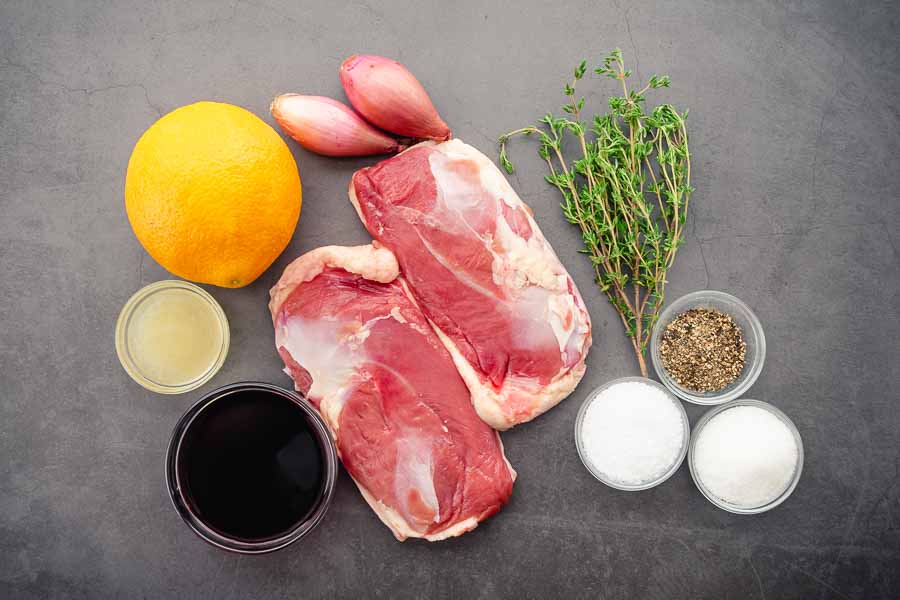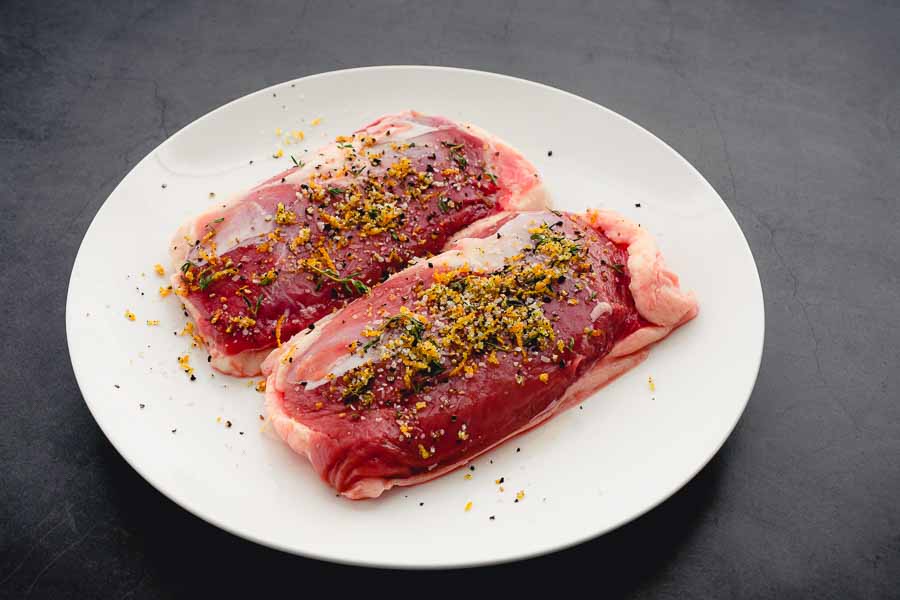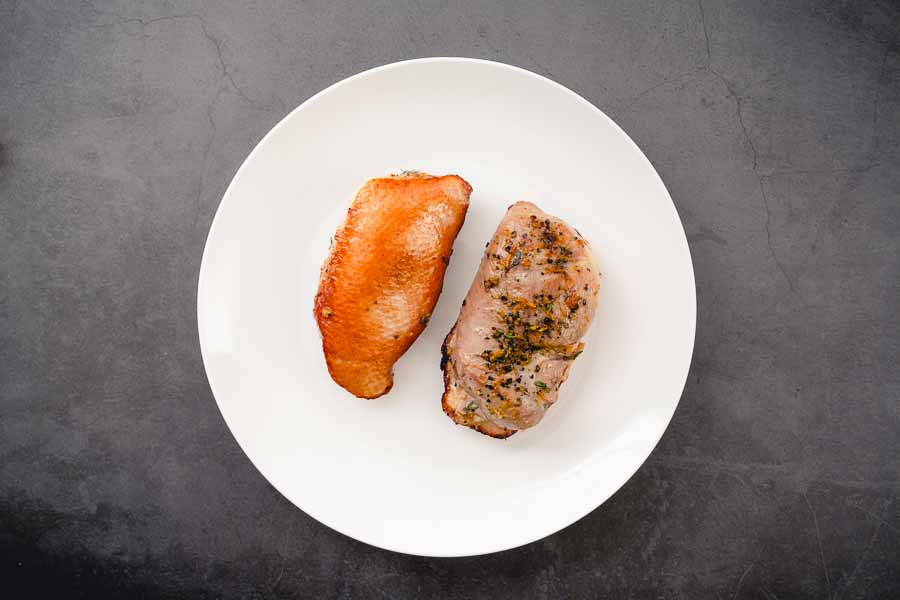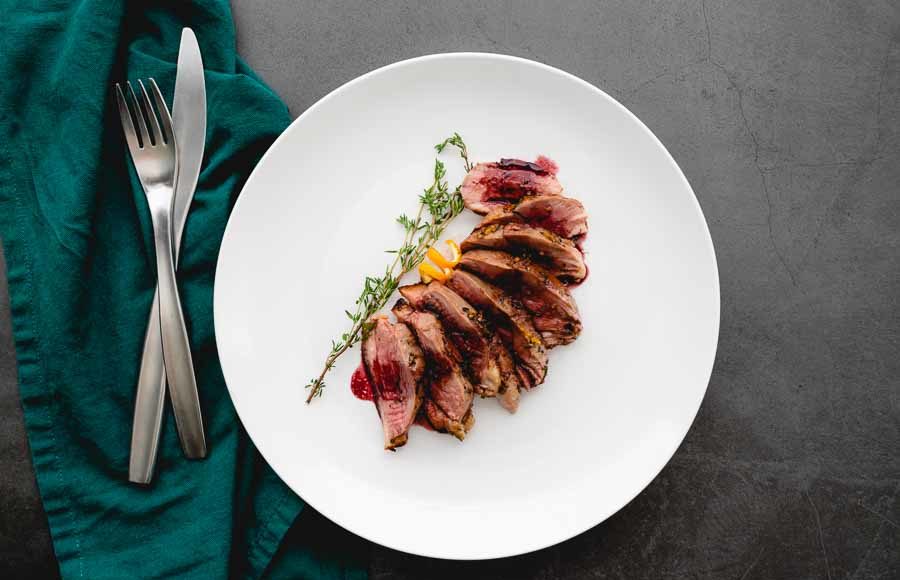I’m always on the lookout for new things to try. Familiar things are always comforting, but new things are exciting. And let’s face it, life is full of the familiar. I need a little excitement now and then. That’s why today’s recipe sounded so appealing to me. I’ve never tried duck, but I’ve always wanted to. It looks so different from the chicken breasts I’m used to! Shoot, it looks different than any poultry I have ever had. It’s red breast meat. What could it possibly taste like? Well, I’m about to find out with this Pan-Seared Wild Duck Breast with Port Wine Reduction recipe. Join me!
Seared Duck Breast with Port Wine Reduction — it’s a dish fit for a bistro menu. Truly, the sauce tastes as if it took hours to prepare, as if pans loaded with veal bones had to be roasted, as if those bones then had to simmer into a rich stock, and as if that stock had to reduce to a syrup. It’s the sort of sauce that elicits comments such as, “I could bathe in this.” I promise you, anyone could make this sauce. It’s foolproof.
The Ingredients
This recipe is actually two separate recipes: one for the duck breasts and one for a port wine sauce. I made sure I had both saved and started making my grocery list.
The most important part was the duck breasts, and I was able to find them at Wild Fork. They had individually packaged 7-ounce Pekin duck breasts for $7.28 each. A little pricey, but not too bad for a special dinner.
I had kosher salt, black pepper, and sugar in my pantry. And I had some homemade chicken stock in my freezer. I never thought I would be one of those people who makes their own stock, but I have gotten into the habit. It’s leaps and bounds better than the boxed stuff!
That left me to buy an orange, a couple of shallots, a package of fresh thyme, and a bottle of port. Like the author, I couldn’t find anything labeled “ruby port” so I just bought the cheapest bottle I could find. I believe it was around $8 for a 750ml bottle.

The Process
I divided this recipe into three phases: marinating the duck breasts, making the port wine reduction, and cooking the duck breasts. I have to say that I had no idea what to expect, but it was really easy!
Day One
Things kicked off with seasoning and marinating the duck. The spice rub was so simple to make, and the whole process took me all of 3 minutes. The recipe gives the option of marinating for as little as 4 hours, but I allowed the duck to marinate overnight.

The author also gives tips on making the port wine reduction ahead of time, so I decided to go that route. With only three ingredients, the sauce was even easier than the spice rub. Just slice the shallots, add them to a saucepan with the port, and wait.
Most of the “work” is simply waiting for it to reduce. You do have to keep an eye on it, though, to ensure it doesn’t reduce too much. Otherwise, you might end up with a burned syrup.
Day 2
The next day, I decided I would have duck breast for lunch. I just couldn’t wait until dinner! I took the seasoned duck breasts and sauce out of the refrigerator so they could warm up for 20 minutes. At the same time, I preheated the oven and a cast iron pan (my stove is electric, and I set it at 4).
This step is the only place I had a pause, but it was not the recipe’s fault. Step 2 says to use a paring knife to remove the tenderloin. I’m familiar with that cut on a chicken breast, but I didn’t see one on the duck breasts. I’m pretty sure the tenderloins were already trimmed, so I just skipped this step.
The instructions call for the duck to be briefly fried on the stove then moved into the oven, flipped (tongs are handy for flipping), and cooked a bit longer. Everything went according to the instructions, and I soon had two beautiful duck breasts prepared in no time.
I finished reducing the sauce while the duck sat for 5 minutes, then I sliced it and served. Here’s how my time was spent on everything:
- 3 minutes to prep the duck breasts
- 8 minutes to prep the port wine reduction
- 45 minutes to cook the reduction
- 8 minutes to cook the duck
- 5 minutes to stand
- 1 hour 9 minutes total (not including time to marinate)
The overall time was a little longer than what was listed on the recipes. However, the cooking times for the duck breast and sauce were perfect.


I came across this recipe at Alexandra’s site. FYI, wild duck breasts and domestic duck breasts are miles apart. Wild waterfowl spend their lives flying, often thousands of miles each year. As a result, their meat is very different from a domestic duck that spends most of it’s life swimming or walking. Wild duck breasts are deep red in color with very little fat, while domestic duck breasts look almost like chicken with a lot of fat. Seldom does a recipe for one, work well for the other. All wild waterfowl are best eaten when cooked rare or medium-rare, anything more and it’s ruined. Wild waterfowl have a very earthy flavor while domestic is more subdued. Glad the recipe worked for you.
I had no idea the difference would be so stark, but it makes sense, so thank you for the tip. The duck breasts I found had very deep red meat, and the color took some getting used to. Cooking them so quickly was a trust-the-process experience too. Can you tell this was my first water fowl recipe? 🤣 I really did get lucky using domesticated duck without a meat thermometer! My next step is updating my notes. I think about this recpe now and then, but I haven’t had the chance to make it again. This might be the sign LOL 🙂